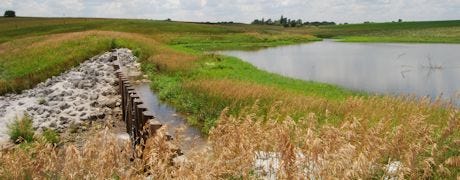October 6, 2013

FAQ: In September USDA announced 33 Conservation Innovation Grants awarded to entities across the nation to develop and demonstrate new ideas to put more natural resource conservation on private lands. What is the CIG grant program?
Answer: Grant recipients will demonstrate innovative approaches to improve soil health, conserve energy, manage nutrients and enhance wildlife habitat in balance with productive agricultural systems. USDA's Natural Resources Conservation Service administers this competitive grants program. Following is more information provided by the USDA press release announcing this latest round of CIG grants.

CONSERVATION INNOVATION: The latest round of funding for USDA Conservation Innovation Grants was announced in late September. CIG grants are used to help improve soil and water conservation technologies and develop new ways to put natural resource conservation on private lands.
"Conservation Innovation Grants activate creativity and problem-solving to benefit conservation-minded farmers and ranchers," U.S. Secretary of Agriculture Tom Vilsack says. "These grants are critical for developing and demonstrating new ideas for conservation on private lands and strengthening rural communities. Everyone relies on our nation's natural resources for food, fiber and clean water and will benefit from these grants."
NRCS chief Jason Weller adds, "The Conservation Innovation Grant program brings together the strength and innovation of the private and nonprofit sectors, academia, producers and others to develop and test cutting-edge conservation tools and technologies and work side-by-side with producers to demonstrate how solutions work on the land."
These partnership grants help develop new approaches to soil and water conservation
As climate changes, extreme weather events are becoming more common, these partnership grants drive cutting-edge conservation techniques that can help make our nation's landscape more resilient to these changes.
The recently announced awards total $13.3 million. Six of the approved grants support conservation technologies and approaches to help farmers who historically haven't had equal access to agricultural programs because of race or ethnicity, or who have limited resources, or who are beginning farmers and ranchers.~~~PAGE_BREAK_HERE~~~
The 33 grants announced in September include:
* U.S. Endowment for Forestry and Communities: A grant of $700,000 to demonstrate sustainable forestry technologies and create a support system and market access for historically underserved landowners in South Carolina, North Carolina and Alabama.
* Wes-Mon-Ty Resource Conservation and Development Council: A grant of $49,000 to demonstrate the use of low-cost technology on a demonstration farm to expand cover crop adoption by historically underserved, small-scale specialty crop producers in West Virginia.
* Pheasants Forever: A grant of $631,218 to explore and demonstrate ways to integrate pollinator habitat into bioenergy crop production systems.
* University of Tennessee: A grant of $634,107 to quantify and demonstrate the long-term impacts of cover crops, crop rotations and no-till farming systems on soil health and crop productivity.
* Conservation Technology Information Center: A grant of $482,000 to work with farmers in the Midwest, to examine and share economic, agronomic and environmental benefits of various cover cropping methods.
* National Fish and Wildlife Foundation: A grant of $821,324 to demonstrate and expand the use of manure injection technology in the Chesapeake Bay watershed, which can significantly reduce nutrient losses from animal agriculture production systems.
The grants are funded through the USDA/NRCS Environmental Quality Incentives Program. Grantees must work with producers and forestland owners to develop and demonstrate the new technologies and approaches.
Grant recipients pay 50% of total cost of CIG projects
At least 50% of the total cost of CIG projects must come from non-federal matching funds, including cash and in-kind contributions provided by the grant recipient. NRCS has offered CIG grant program since 2004, investing in ways to demonstrate and transfer efficient and environmentally friendly farming and ranching. In the past nine years, the grants have helped develop trading markets for water quality and have shown how farmers and ranchers may use fertilizer, water and energy more efficiently.
Sec. Vilsack says this is another reminder of the importance of USDA programs to rural America. A comprehensive five-year Food, Farm and Jobs Bill would further expand the rural economy, Vilsack adds, saying that is just one reason why Congress must get a comprehensive bill done as soon as possible.
For more on this grant program, visit USDA's Conservation Innovation Grants web page or contact your local NRCS office.
You May Also Like




